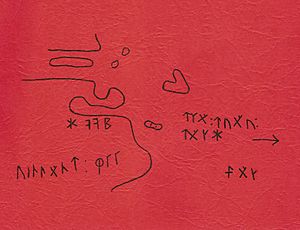Spirit Pond runestones facts for kids
The Spirit Pond runestones are three special stones found near Spirit Pond in Phippsburg, Maine. A carpenter named Walter J. Elliott, Jr. discovered them in 1971. These stones have markings that look like runic inscriptions, which are ancient letters used by people in Northern Europe, like the Vikings.
Today, the stones are kept at the Maine State Museum. However, many experts believe they are not real ancient artifacts. They think the stones might be a trick or a mistake. If the stones were truly ancient, they would show that Vikings or other Europeans visited America long before Christopher Columbus. This idea is called pre-Columbian trans-oceanic contact. It would also mean that the Norse people (Vikings) settled in North America.

Contents
What Are Runestones?
Runestones are usually large stones with carvings called runes. Runes were an alphabet used by Germanic people, including the Vikings, from ancient times up to the Middle Ages. These carvings often tell stories, remember important people, or mark special events. Finding a real runestone in North America would be a huge discovery! It would change what we know about history.
The Discovery of the Spirit Pond Stones
In 1971, Walter J. Elliott, Jr. was exploring near Spirit Pond. He found three stones that seemed to have strange carvings on them. He thought they looked like runes. People got very excited because it seemed like proof that Vikings had traveled far into North America.
The Three Stones
The three stones are:
- A "map stone" that some people think shows a map of the area.
- A "text stone" with what looks like a long message written in runes.
- A "poem stone" that seems to have a poem carved into it.
The carvings on these stones are quite unusual. They don't look exactly like known Viking runes. This is one reason why many experts are doubtful about them.
Why Experts Are Skeptical
Most historians and language experts (called linguists) do not believe the Spirit Pond runestones are real. They have several reasons for this:
- Unusual Runes: The runes on the stones don't quite match the types of runes used by Vikings. Some look like a mix of different rune styles or even modern letters.
- Modern Tools: Some experts believe the carvings were made with modern tools, not ancient ones.
- No Other Evidence: If Vikings had been in that exact spot, we would expect to find other things, like tools, homes, or graves. So far, nothing else has been found at Spirit Pond to support the idea of a Viking settlement.
- Similar Hoaxes: There have been other "runestones" found in North America that were later proven to be fakes. The most famous is the Kensington Runestone, which was also found to be a hoax.
What is a Hoax?
A hoax is a trick or a prank. In archaeology, a hoax means someone has created a fake artifact and tried to pass it off as real. Sometimes people do this for fun, to get attention, or even to try and prove a historical theory. It's important for scientists to carefully study any new discovery to make sure it's real.
The Debate Continues
Even though most experts think the Spirit Pond runestones are not real, a few people still believe they could be authentic. They argue that the runes might be a very rare or unknown type, or that more research is needed. However, the strong evidence against their authenticity means they are not accepted as true historical artifacts by the wider scientific community.
The Spirit Pond runestones remain an interesting mystery. They remind us that while new discoveries are exciting, it's important to always check the facts carefully!


